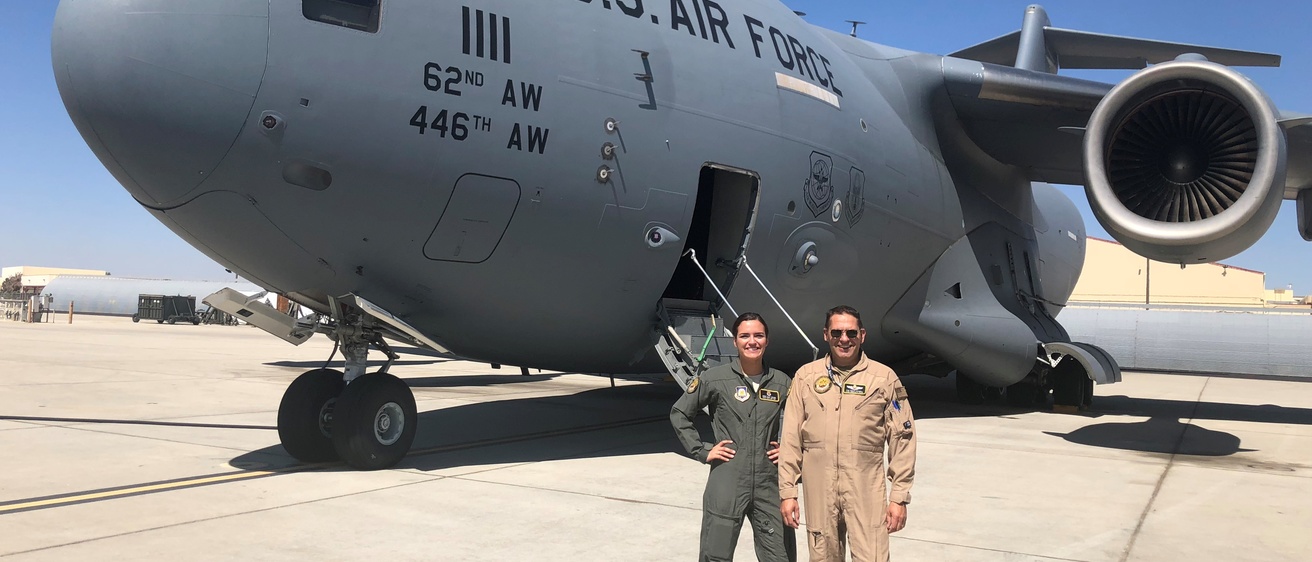Tom "MACH" Schnell, Captain Jim "Max" Gross Chair in Engineering at the University of Iowa, and his team received the Best Paper Award at the 2019 Annual Meeting of the Society of Experimental Test Pilots in September 2019. Schnell is a professor of industrial and systems engineering, director of the UI's Operator Performance Laboratory, and associate director of the University of Iowa Technology Institute.
The paper, “Objective Measures of Pilot Workload: Beyond Cooper-Harper with Biometrics,” was part of an engineering feasibility study to determine the value of using physiological based workload assessment technology in the process of AT certification. The lead author on the paper was Lt. Col. Paul "PROMO" Calhoun and Schnell and Maj. Calvin "DATA" D'Silva were co-authors. Both Lt. Col. Calhoun and Maj. D'Silva are from the 418th Flight Test Squadron. OPL brought its Cognitive Assessment Tool Set (CATS) kit to the 418th at Edwards AFB. The system was set up inside an instrumented C-17 aircraft acting as a receiving aircraft against a legacy KC-135 tanker. On two of the four flights, alongside CATS, OPL used the Dikablis Professional eye-tracking glasses in conjunction with D-Lab software from Ergoneers. This work involved numerous people including Abbie Moore, Colton Thompson, and Ezekiel Gunnink, all employees of OPL, and was funded by the United States Air Force.
Aerial Refueling (AR) represents a cornerstone of the USAF air warfare capability. Aircraft must be proven ready to be a tanker or receiver and new AR technologies must be assessed by the 418th FLTS (412 TW) to be certified for operational use. Certification includes test procedures of both the giving and receiving aircraft separately and then again as certified pairs. Many factors such as gross weight, flight speed, maneuvering (banking, climbing), structural dynamics, bow waves, etc. influence the operational behavior of a tanker and receiver pair. Some of these factors interact only when the pair is formed up into a coupled system during receiving. Many components of performance make up the approval battery of certification. These include (but are not limited to) handling qualities, adequacy of controls and displays, adequacy of communications and procedures. Additionally, crew workload and attention requirements are an important factor. If it takes an inordinate amount of concentration and off-scale flying skills to keep station during receiving, both the receiving pilot and the boom operator will “wear out” quickly or in a worst case, be unable to refuel. This can have dramatic consequences. Added circumstances of actual air warfare such as minimal fuel at join-up, bad weather, battle stress, etc. may compound the problem and cause the AR task to be unsuccessful.
Traditional AR installations such as in the KC-135 tanker involve an intrusive modification to the tanker airframe. The boom operator is situated in a prone (belly down) position looking out through a window in the tail section of the tanker. This installation is very costly because the pressurized airframe must be cut open and a structural window must be installed. Newer tanker configurations such as KC-46, KC-767, and KC-30 use a system of remote, tail-mounted cameras and a boom operator who is situated in a crew compartment within the aircraft. A structural window modification is no longer needed. The cameras are intended to provide a stereoscopic image of the area that was formerly seen through the window in the tail in the legacy airframes.
Viewing mechanisms involve stereoscopic screens and polarized glasses or Virtual Reality (VR) headsets. As these newer systems work their way through certification into operational use, issues are discovered that affect the boom operator’s ability to perform the AR task. The remote vision systems show degraded modes that cause blooming or loss of contrast during thermal crossover. Due to parallax between the tail mounted cameras, two booms may be seen, merging into one along the length of the boom. In some angular configurations, one receiving aircraft may show up as two, causing the potential for boom operator startling and confusion. The legacy system (boom operator Mark I eyeball) has 20/20 vision to detect the approaching aircraft. The remote camera systems are 20/30 to 20/60 equivalents and thus fall short in that regard.
Furthermore, because the cameras are typically separated by a larger distance than the human interpupillary distance (IPD), the observed images are hyper-stereoscopic with exaggerated depth. This can cause problems in operators when going in and out of the viewing environment. Another concern is that the legacy system provided the boom operator with haptic feedback of the boom’s flight toward the receiving aircraft, crossing over the bow wake, and making contact with the receptacle. This detailed haptic feedback is no longer available to the boom operator in the newer concepts. Even auditory feedback was available in the legacy airframe. The boom operator could hear the rushing of the fuel through the pipes over his head, thus providing unambiguous multi-sensory evidence that fuel was flowing.
The boom operator in the tanker and the pilot in the receiving aircraft are a coupled human-machine system. If the boom operator is having trouble due to high workload, this is going to affect the receiving pilot and make his job harder.
Therefore, assessment of both the boom operator and pilot workload is of great interest to the 418th as part of AR certification.
